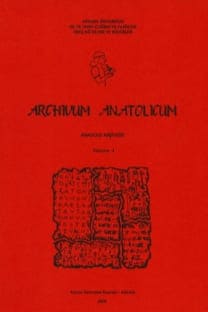Bir Kültepe Metninde Kaydedilen “Hurātum Rabiātum”
Ağırlık ölçülerinin aksine uzunluk ölçülerinin kaydedildiği
Kültepe metni çok azdır. Bu ölçü birimleri; daha ziyade kumaşların
boyutlarını, sadece birer metinde ise ağacın enini-boyunu ve sofranın
(paššuru) uzunluğunu ifade etmekte kullanılmıştır. 1988 yılı
kazılarında bulunan kısa bir tablette, Eski Asurca metinlerde daha
önce merdivenlerin uzunluğunu belirtmek üzere geçmeyen uzunluk
ölçülerinden ammatu ve merdivenlerin basamaklarının sayısını ifade
etmek üzere nakbisu kelimeleri kaydedilmiştir. Belgede merdivenin
büyük olacağı (6 metre) ve 15 ya da 16 basamağının bulunacağı ifade
edilmiştir.
Anahtar Kelimeler:
Hurātum, nakbisu, ammatu, kübit, kumaş ölçüleri, Kültepe, merdiven, merdiven basamağı
"Hurātum Rabiātum" in the Kültepe Text
Contrary to weight measures, texts from Kültepe that mention
linear measures are very few. Measures of length in the texts are
generally used to indicate the dimensions of textile, and once for the
length and width of a piece of timber or the length of a dining tray
(paššuru). The brief text published here was unearthed at Kültepe in
1988 and refers to ammatu, one of the linear measures, to describe the
length of a ladder and its nakbisu, to specify the number of the steps
on that ladder. In the text, it is stated that the ladder should be long
(about 6 meters) and have fifteen to sixteen steps.
Keywords:
hurātu, nakbisu, ammatu, cubit, dimensions of textiles, Kültepe, ladder, steps on a ladder,
___
- AHw W. von Soden, Akkadisches Handwörterbuch, Wiesbaden 1958-1981.
- ARM Archives royales de Mari
- BIN 4 Clay, A. T., Letters and Transactions from Cappadocia, Babylonian Inscriptions in the Collection of James B. Nies IV, Yale 1927.
- CAD Chicago Assyrian Dictionary.
- CCT CCT 1-6 Cuneiform Texts From Cappadocian Tablets in the British Museum, London.
- CDA J. Black - A. George - N. Postgate, A Concise Dictionary of Akkadian, Wiesbaden 2000.
- GKT K. Hecker, Grammatik der Kültepe-Texte, Analecta Orientalia 44, Roma 1968.
- Kahya 2014: Ö. Kahya, “Kültepe Metinlerinde Geçen Himtum Kelimesinin Anlamı Üzerine”, ArAn 9/1, 2014, 57-72.
- MKT O. Neugebauer, Mathematische Keilschrifttexte, Berlin, Springer 1935-1937.
- OIP 27 Gelb, I., Inscriptions from Alishar and Vicinity, Oriental Institute Publications (OIP) 27, Chicago 1935.
- Or. Orientalia (Band der Nova Series; alte Serie = Or. Nr.).
- Özgüç 2005: T. Özgüç, Kültepe, Kaniš/Neša, Y.K.Y., İstanbul, 2005.
- Postgate 1988 J. N. Postgate, The Archive of Urad-Šerūa and his family, A Middle Assyrian household in government service, 1988.
- TC 1 G. Contenau, Tablettes cappadociennes du Louvre, TCL 4, Paris 1920.
- TC 3 J. Lewy, Tablettes cappadociennes du Louvre, TCL 19, 20 and 21, Paris 1935-1937.
- Veenhof 1972: K.R. Veenhof, Aspects of Old Assyrian Trade and its Terminology, Leiden, 1972.
- Michel-Veenhof 2010: C. Michel - K. R. Veenhof, “The Textiles Traded by the Assyrians in Anatolia (19th–18th centuries BC)”, In C. Michel and M. L. Nosh (eds), Textile Terminologies, in the Ancient Near East and Mediterranean from the Third to the First Millennia BC, Ancient Textiles Series 8. Oxford, 2010, 210-271.
- ISSN: 1300-6355
- Yayın Aralığı: Yılda 2 Sayı
- Başlangıç: 1995
- Yayıncı: Ankara Üniversitesi
Sayıdaki Diğer Makaleler
Bir Kültepe Metninde Kaydedilen “Hurātum Rabiātum”
Sembollerden Çiviyazısına Geçiş ve Yazının Anadolu’ya Gelişi
Kültepe’den Amūtum’un Eksilmesi Hakkında Bir Mektup
Yazılı Kaynaklar Işığında Yeni Asur Ordusunun Sefer Sürecinde Erzak Temin Yöntemleri
